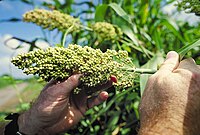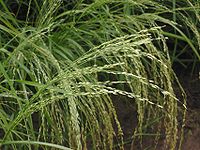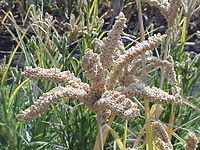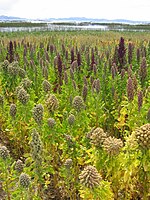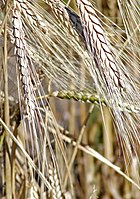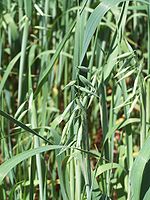Ancient grains
Ancient grains is a marketing term used to describe a category of grains and pseudocereals that are purported to have been minimally changed by selective breeding over recent millennia, as opposed to more widespread cereals such as corn, rice and modern varieties of wheat, which are the product of thousands of years of selective breeding. Ancient grains are often marketed as being more nutritious than modern grains, though their health benefits over modern varieties have been disputed by some nutritionists.[1][2]
Ancient grains include varieties of wheat:
History
The origin of grains goes back to the Neolithic Revolution about 10,000 years ago, when prehistoric communities started to make the transition from hunter-gatherer to farmer. Modern varieties of grains have been developed over time through mutation, selective cropping, breeding and research in biotechnology.[8][9] Ancient grains, however, are said to be largely unchanged from their initial domesticated varieties.[1]
Various forms of
Ancient grains played a role in the spiritual life of several ancient civilizations, from the
The first reference to ancient grains as a health food was in
Types
Wheat
Archaeobotanical studies indicate three species of
The
Some grains found in India are:[10]
- Triticum sphaerococcum - also called "Indian Short Wheat", this is the earliest known cultivated wheat from India with evidence from the Chalcolithic site Harappa and the later site Ter
- Mohenjodaro and Navdatolo
- Triticum compactum - found at Harappa, Mundigak and Mohenjodaro
- Kayatha
- Triticum Sp. Contd. - found at Songaon, Rohtak, Nevasa and Bhokardan
Barley
Along with wheat,
Rice
Rice is believed to have been cultivated at Non Nok Tha in Thailand since 3500 BC where impressions of grains of rice have been found on potsherds. Other cultivation sites include the Neolithic sites of Yangshao, Liu Tzuchen, Anhui, Kionsi, Zhejiang and Hubei.[10]
Wild rice
Not directly related to domesticated rice,
Millets
The origin of
Cultivation of pearl millet is known from sites with semi-arid climate, occurring at Hallur, Rangpur and Nevasa. Cultivation of pearl millet in modern India (where it is also called bajra) is mostly limited to the country's semi-arid regions. In Africa evidence has been found dating to the Naghez phase, but it is not known whether these were cultivated. Both wild and cultivated grain impressions were found at Le Baidla I.[10]
Charred grains of
Nutritional claims
This section needs more primary sources. (June 2018) |  |
Ancient grains are rich in protein, some micronutrients, and dietary fiber.[1] Some nutritionists state that they are not inherently more healthful than modern grains, and that ancient and modern grains have similar nutritional content when eaten as whole grains.[1][16]
Some, but not all, ancient grains are gluten-free. Amaranth, quinoa, buckwheat, millet, and teff are gluten-free, but the ancient kinds of wheat (including spelt, einkorn, and Khorasan wheat) are not.[1][16]
Gallery
-
Amaranthus
-
Khorasan wheat (Kamut)
See also
- List of ancient dishes and foods
- Neolithic founder crops
- Whole grain
References
- ^ a b c d e f Conis, Elena (19 February 2011). "Ancient grains: The best thing since sliced bread?". Los Angeles Times. Retrieved 22 October 2015.
- ^ a b c d Joanna Jolly (16 December 2014). "Why do Americans love ancient grains?". BBC News. Retrieved 19 October 2015.
- ^ a b Clark, Melissa (13 March 2015). "Know Your Heirloom and Ancient Grains". The New York Times. Retrieved 22 October 2015.
- ^ a b Dan Charles (8 December 2014). "'Ancient Grains' Go From Fringe Food To New Cheerios Variety : The Salt". NPR. Retrieved 22 October 2015.
- ^ Vara, Vauhini (24 October 2014). "Why We're Willing to Pay More for Cereals with Ancient Grains". The New Yorker. Retrieved 22 October 2015.
- ^ a b Zevnik, Neil (7 January 2014). "Ancient Grains: Everything Old Is New Again". Huffingtonpost.com. Retrieved 13 November 2015.
- ^ Charlie Fox, Freekeh Recipes: A Guide to Cooking with this Ancient Grain, 2020
- PMID 19386614.
- ^ PMID 26151025.
- ^ a b c d e f g h i Kajale, M. D. (1974). "Ancient Grains from India". Bulletin of the Deccan College Post-Graduate and Research Institute.
- ^ Sullivan, Rebecca (17 January 2014). "Ancient grains: why you should eat these six superfoods eaten by the Aztec". News.com.au. Retrieved 13 November 2015.
- ^ Maisto, Michelle (5 December 2011). "Rediscovering Amaranth, The Aztec Superfood". Forbes. Retrieved 13 November 2015.
- ISBN 978-1-133-00838-5.
- . Retrieved 17 June 2022.
- S2CID 26628330.
- ^ a b Storrs, Carina (18 May 2015). "'Natural,' other food labels that may not be legitimate". CNN. Retrieved 13 November 2015.


